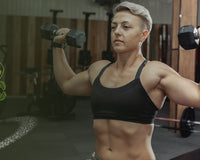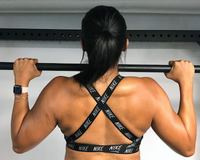
The RFE Split Squat
Also known as the Bulgarian split squat, the RFE (rear foot elevated) split squat is one of the best unilateral squat variations. This compound exercise will help you build serious leg and glute strength.
Put simply, the RFE split squat can take your lower body strength training to the next level.
Muscles Worked By The RFE Split Squat
Primary Muscle Groups:
The RFE split squat primarily works the quadriceps and the glutes. The four muscles in the front of your leg that comprise the quadriceps are the rectus femoris, vastus intermedius, vastus medialis, and the vastus lateralis.
The Bulgarian split squat intensely activates the quadriceps muscles, which increases hypertrophy in these muscle cells.

In addition, the glutes receive a significant amount of tension during the RFE split squat.
The gluteus maximus, medius, and minimus make up the gluteal muscles. While this exercise targets all three muscles of the glutes, the gluteus maximus is most engaged during the movement.
The RFE split squat guarantees a very strong contraction of the gluteal muscles.

Secondary Muscle Groups:
The RFE split squat secondarily works the core, hamstrings, adductors, and calves. As you lower to the floor, your core is responsible for stabilizing your body to maintain balance.
Your hamstrings play a similar role in the motion. When you perform the Bulgarian split squat, your hamstrings support your quadriceps by reinforcing the lower part of the leg to help you complete the exercise with proper form. Lastly, the adductors and calves similarly act to stabilize the lower body.
Bulgarian Split Squat Benefits
1. Size And Strength Gains
The RFE split squat places a great stress on your quadriceps, glutes, and hips. When the human body is safely stressed, it responds by strengthening and enlarging the stressed muscles. These lower body muscles are important for explosive movements such as running, jumping, or other exercises like the traditional squat or deadlift.
Whether you are a weightlifting record holder or someone completely new to fitness, your lower body strength provides a stable base that you can rely upon to accomplish your goals.
2. Improved Muscle Imbalances
The bulgarian split squat is a perfect exercise to train one leg at a time. Many people develop muscle imbalances due to prior athletic experiences or injury. If one of your legs is stronger than the other, you can learn how to do this split squat to even out your muscle imbalances.
3. Convenience
Another major benefit of the RFE squat is its convenience factor. There is absolutely zero gym equipment needed to perform this exercise. All you need is a chair, couch, or similar elevated surface and you are good to go!
How To Do The RFE Split Squat
Equipment:
To perform the Bulgarian split squat, all you need is an elevated surface (bench, chair, couch, etc.).
Setup:
a) Begin by placing your trail foot on the elevated surface behind you.
b) Step outwards with your lead foot so that your trail leg is slightly bent.
Action:
a) Lean slightly forward and keep your back straight.
b) Engage your core and squat downwards into your front leg.
c) Pause for a moment at the bottom of the rep and drive upwards with your lead leg.
d) Maintain tightness in your core and repeat!

Recommendation:
The RFE split squat may seem challenging at first, as it requires advanced balance and strength. With single leg split squats, perform 3-4 sets of 10-15 repetitions to become comfortable with the form. Of course, feel free to switch up the set and rep ranges to challenge yourself.
RFE Split Squat Mistakes
1. Leaning Backward
One common mistake made during the Bulgarian split squat is leaning backward and placing too much weight on your trail foot. This can lead to a hyperextended back position, which places excessive stress on your spine.
Leaning into your trail foot also reduces tension on your front leg, which minimizes your potential gains.
Instead, keep most of your weight on your front foot and lean forward slightly to maximize the effectiveness and safety of the RFE split squat.
2. Moving Your Weight Back And Forth
While you do want to lean slightly forward during the RFE split squat, avoid shifting your weight back and forth during the exercise motion. Far too often, weightlifters tend to shift their weight onto their toes as they squat downwards and back onto their trail foot as they drive upwards.
This weight shift forward places the front knee under too much stress. Instead, you should feel like you are squatting up and down on a vertical plane without moving your weight back and forth.
3. Standing Too Close To The Elevated Surface
Another common RFE squat mistake is standing too close to the bench/chair/couch. This mistake restricts your range of motion and can cause your front heel to come up off the ground as you squat down.
This places your ankle in a precarious position and reduces the tension on your front leg. Instead, step out further until you can comfortably squat down while keeping your heel on the ground.
RFE Split Squat Variations
1. Barbell RFE Split Squat
If you feel as though you have mastered the bodyweight Bulgarian split squat, try adding some weight. Grab a barbell and add on light to medium weight.
Then, perform the barbell RFE split squat with the same form as the bodyweight variation.

2. Zercher Bulgarian Split Squat
The Zercher RFE split squat is a variation of the standard barbell Bulgarian split squat. Instead of placing the barbell on your back, secure it in the crook of your arms.
This variation engages your biceps and forearms while simultaneously working your lower half, making it a true total body workout.

3. Dumbbell RFE Split Squat
The dumbbell Bulgarian split squat offers another way to add weight to the exercise motion. Holding the dumbbells can help boost forearm activation and improve your grip strength.
If you feel like you need a bigger challenge than the bodyweight RFE squat, grab a pair of dumbbells!

RFE Split Squat Alternatives
If you enjoyed the RFE split squat, check out these other leg and glute exercises to improve your lower body training:
1. Single Leg RDL
Assume a standing position with your feet close together. Place all of your weight on one foot and balance in this position. Engage your core and bring your shoulder blades back and down.
While keeping your back straight, sit your hips back and begin to bend forward. Keep leaning forward until your back is roughly parallel to the floor. You should feel a deep stretch in your hamstrings.
Now, reverse the motion as you return to the standing position and squeeze your glutes. Maintain tightness in your core and repeat!

2. Alternating Side Lunges (Weight Optional)
Assume a standing position with your toes slightly flared out and your feet wider than shoulder width apart.
Keeping your left leg straight, bend your right knee and shift your weight to your right side. Then, transition to the starting position and repeat on the left side. Keep switching legs!

3. Curtsy Lunge
Start from a standing position with your chest held high and your back straight.
With your left foot straight in front of you, step with your right foot back and to the left. Both of your knees will bend and your legs will be “crossed.” Make sure your left knee is directly over your left ankle. At this point, you will look like you are doing a curtsy!
Next, drive upwards in a controlled fashion to the standing position. Repeat this motion with your right foot out in front. You can switch legs after each repetition or after each set.

Looking For An Intense Lower Body Workout?
Follow along to this 5 minute at home quad workout!
Join the Invasion!
This Anabolic Aliens membership will grant you access to workout classes, rehab programs, diet plans, and more exclusive content to help you achieve sustainable success!










